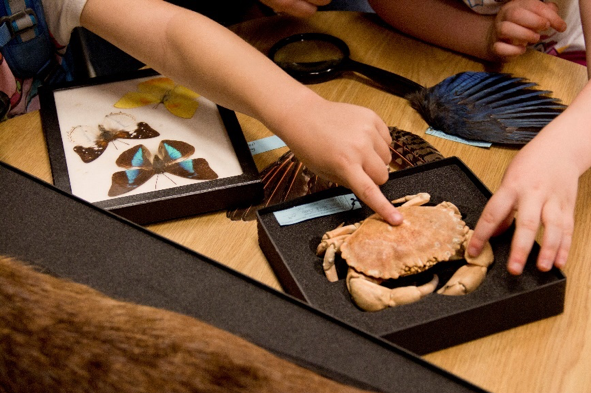| Duration | 75 minutes |
| Child, Youth, Student and Senior | $ 9.00 |
| Adult | $12.00 |
* Please see booking information for more details.
Join us in an exploration of amazing adaptions! Students will get hands-on with museum specimens, exploring unique features and how living things interact with their environments. Students will think like a scientist as they explore the museum searching for adaptations and evolution. Along the way, you’ll learn about scientists who study ecology and evolution at UBC!
Targeted Curriculum
- Science 4: All living things and their environment are interdependent
Features of biomes, organisms in ecosystems sense and respond to their environment - Science 5: Multicellular organisms have organ systems that enable them to survive and interact within their environment
- Science 6: Multicellular organisms rely on internal systems to survive, reproduce, and interact with their environment
- Science 7: The theory of evolution by natural selection provides an explanation for the diversity and survival of living things
Natural selection through adaptation radiation – a proposed mechanism of the theory of evolution, survival needs and interactions between organisms and the environment - Arts Education 3-5: Connect knowledge and skills from other areas of learning in planning, creating, and interpreting works of art
- English Language Arts K-4: Stories can be told through pictures and words, everyone can be a reader and a writer
Resources
We encourage you to plan to arrive early and/or stay late after your program is finished, so you can explore the museum collections more fully. We have a wide variety of educator resources to support you before, during, and after your visit. Here are some suggested ways to frame your exploration:
Before your visit:
- Get to know our space, enjoy an audio tour or 360° virtual tour of the museum, using our online visitor guide (html) or printable visitor guide (pdf) to help navigate the museum.
- Explore our museum terminology sheet and Researchers Revealed site
- Build an ecosystem in your classroom
- Listen to a reading by Dr. Greg Bole as Charles Darwin from “On the Origin of Species”
At the museum:
- Look for Culture at the Centre and the Sturgeon Knowledge Web exhibits sharing First Peoples’ knowledge and perspectives on biodiversity.
- Check out the current exhibitions
After your visit:
- Learn about more research happening at UBC with our Researchers Revealed online exhibition.
- Check out the Beaty Biodiversity Museum Phylo cards page, the PDF of the downloadable Beaty Phylo cards, and Phylogame.org for the rules and guidelines of the game and other information. If you’d like to create your own cards, you can download a template that includes instructions for a simplified game.
- Colour this page of budding yeast, a model organism for evolutionary experiments.
Accessibility notes
We will move around the museum which is equipped with level concrete flooring and ramps. There are no lips or steps to get to all program areas. Some spaces in the museum are dark and/or narrow but can fit a wheelchair easily. Expect to spend some time walking, standing, and sitting. Students may work in pairs, small groups, or as a large group. Activities may incorporate drawing or writing, touching real museum specimens, and discussions. Read more about accessibility in the museum here. We will ensure we get all group members to participate in a way that works for them. Let us know how we can meet the access needs of your group!

